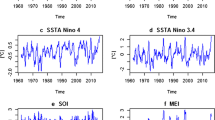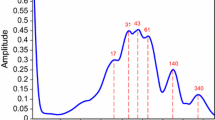Abstract
We show that the monthly recorded history (1866–2014) of the Southern Oscillation Index (SOI), a descriptor of the El Niño Southern Oscillation (ENSO) phenomenon, can be correctly described as a dynamic system supporting a potential nonlinear predictability well beyond the spring barrier. Long-term predictability is strongly connected to a detailed knowledge about the topology of the attractor obtained by embedding the SOI index in a wavelet base state space. By utilizing the state orbits on the attractor, we show that the information contained in the SOI is sufficient to provide nonlinear attractor information, allowing the detection of predictability for longer than a year: 2, 3, and 4 years in advance throughout the record with an acceptable error. This is possible due to the fact that the lower-frequency variability of the SOI presents long-term positive autocorrelation. Thus, by using complementary methods, we confirm that the reconstructed attractor of the low-frequency part (lower than 1/year) of SOI time series cannot be attributed to stochastic influences. Furthermore, we establish its multifractality. As an example of the capabilities of the methodology, we investigate a few specific El Niño (1972–1973, 1982–1983, 1997–1998) and La Niña (1973–1973, 1988–1989 and 2010–2011) events. Our results indicate that each of these present several equivalent temporal structures over other eras of these 149 years (1866–2014). Accordingly, none of these cases, including extreme events, presents temporal singularity. We conclude that the methodology’s simplicity of implementation and ease of use makes it suitable for studying nonlinear predictability in any area where observations are similar to those describing the ENSO phenomenon.







Similar content being viewed by others
References
Abarbanel HD, Brown R, Sidorowich JJ, Tsimring LS (1993) The analysis of observed chaotic data in physical systems. Rev Mod Phys 65(4):1331
Ahmed I (2010) Detection of nonlinearity and stochastic nature in time series by delay vector variance method. Int J Eng Technol 10(2):22–27
Astudillo H, Borotto F, Abarca-del Rio R (2010) Embedding reconstruction methodology for short time series-application to large El Nino events. Nonlinear Process Geophys 17(6):753–764
Bjerknes J (1969) Atmospheric teleconnections from the equatorial pacific 1. Mon Weather Rev 97(3):163–172
Brunner AD (2002) El Nino and world primary commodity prices: warm water or hot air? Rev Econ Stat 84(1):176–183
Burn MJ, Palmer SE (2014) Solar forcing of caribbean drought events during the last millennium. J Quat Sci 29(8):827–836
Capotondi A, Sardeshmukh PD (2015) Optimal precursors of different types of ENSO events. Geophys Res Lett 42(22):9952–9960. doi:10.1002/2015GL066171
Capotondi A et al (2015) Understanding ENSO diversity. Bull Am Meteorol Soc 96:921–938. doi:10.1175/BAMS-D-13-00117.1
Cazenave A, Henry O, Munier S, Delcroix T, Gordon A, Meyssignac B, Llovel W, Palanisamy H, Becker M (2012) Estimating ENSO influence on the global mean sea level, 1993–2010. Mar Geod 35(sup1):82–97
Chen D, Cane MA (2008) El Niño prediction and predictability. J Comput Phys 227(7):3625–3640
Chen D, Lian T, Fu C, Cane MA, Tang Y, Murtugudde R, Song X, Wu Q, Zhou L (2015) Strong influence of westerly wind bursts on El Niño diversity. Nat Geosci 8(5):339–345. doi:10.1038/ngeo2399
Craigmile PF, Percival DB (2002) Wavelet-based trend detection and estimation. In: El-Shaarawi A, Piegorsch WW (eds) Encyclopedia of environmetrics, vol 4. Wiley, Hoboken, NJ, pp 2334–2338
Ding R, Li J (2007) Nonlinear finite-time Lyapunov exponent and predictability. Phys Lett A 364(5):396–400
Ding R, Li J, Ha K (2008) Nonlinear local Lyapunov exponent and quantification of local predictability. Chin Phys Lett 25(5):1919
Ding R, Li J, Zheng F et al (2016) Estimating the limit of decadal-scale climate predictability using observational data. Clim Dyn 46:1563–1588. doi:10.1007/s00382-015-2662-6
Farmer JD, Sidorowich JJ (1987) Predicting chaotic time series. Phys Rev Lett 59(8):845
Feder J (2013) Fractals. Physics of solids and liquids. Springer, Berlin
Fedorov A, Harper S, Philander S, Winter B, Wittenberg A (2003) How predictable is El Niño? Bull Am Meteorol Soc 84(7):911–919
Gautama T, Mandic DP, Van Hulle MM (2004) The delay vector variance method for detecting determinism and nonlinearity in time series. Phys D 190(3):167–176
Golyandina N, Zhigljavsky A (2013) Singular spectrum analysis for time series. Springer, Berlin
Guillas S, Day SJ, McGuire B (2010) Statistical analysis of the El Niño-southern oscillation and sea-floor seismicity in the eastern tropical pacific. Philos Trans R Soc Lond A Math Phys Eng Sci 368(1919):2481–2500
Hsiang SM, Meng KC, Cane MA (2011) Civil conflicts are associated with the global climate. Nature 476(7361):438–441
Huang NE, Shen SS (2005) Hilbert–Huang transform and its applications, vol 5. World Scientific, Singapore
Ihlen EAF (2012) Introduction to multifractal detrended fluctuation analysis in matlab. Front Physiol 3:141. doi:10.3389/fphys.2012.00141
Kantelhardt JW, Zschiegner SA, Koscielny-Bunde E, Havlin S, Bunde A, Stanley HE (2002) Multifractal detrended fluctuation analysis of nonstationary time series. Phys A 316(1):87–114
Kaplan DT, Glass L (1992) Direct test for determinism in a time series. Phys Rev Lett 68(4):427
Kodba S, Perc M, Marhl M (2005) Detecting chaos from a time series. Eur J Phys 26(1):205–215
Komm R (1995) Hurst analysis of Mt. Wilson rotation measurements. Sol Phys 156(1):17–28
Können G, Jones P, Kaltofen M, Allan R (1998) Pre-1866 extensions of the southern oscillation index using early Indonesian and Tahitian meteorological readings. J Clim 11(9):2325–2339
Kovats RS, Bouma MJ, Hajat S, Worrall E, Haines A (2003) El Niño and health. Lancet 362(9394):1481–1489
Landsea CW, Knaff JA (2000) How much skill was there in forecasting the very strong 1997–98 El Niño? Bull Am Meteorol Soc 81(9):2107–2119
Li J, Ding R (2011) Temporal-spatial distribution of atmospheric predictability limit by local dynamical analogs. Mon Weather Rev 139(10):3265–3283
Li J, Ding R (2013) Temporal-spatial distribution of the predictability limit of monthly sea surface temperature in the global oceans. Int J Climatol 33(8):1936–1947
Lorenz EN (1963) Deterministic nonperiodic flow. J Atmos Sci 20(2):130–141
Lorenz EN, Kerry AE (1998) Optimal sites for supplementary weather observations: simulation with a small model. J Atmos Sci 55(3):399–414
Ludescher J, Gozolchiani A, Bogachev MI, Bunde A, Havlin S, Schellnhuber HJ (2014) Very early warning of next El Niño. Proc Nat Acad Sci 111(6):2064–2066
McPhaden MJ, Zebiak SE, Glantz MH (2006) ENSO as an integrating concept in earth science. Science 314(5806):1740–1745
Murguía JS, Rosu HC (2011) Discrete wavelet analyses for time series. In: Olkkonen JT (ed) Discrete wavelet transforms-theory and applications. InTech, Vukovar. doi:10.5772/16016
Neelin JD, Battisti DS, Hirst AC, Jin FF, Wakata Y, Yamagata T, Zebiak SE (1998) ENSO theory. J Geophys Res Oceans (1978–2012) 103(C7):14,261–14,290
Niedzielski T (2014) Chapter two-El Niño/southern oscillation andselected environmental consequences. Adv Geophys 55:77–122. doi:10.1016/bs.agph.2014.08.002
Packard NH, Crutchfield JP, Farmer JD, Shaw RS (1980) Geometry from a time series. Phys Rev Lett 45(9):712
Peng C, Buldyrev S, Goldberger A, Havlin S, Sciortino F, Simons M, Stanley H et al (1992) Long-range correlations in nucleotide sequences. Nature 356(6365):168–170
Peng CK, Buldyrev SV, Havlin S, Simons M, Stanley HE, Goldberger AL (1994) Mosaic organization of DNA nucleotides. Phys Rev E 49(2):1685
Phillips T, Nerem RS, Fox-Kemper B, Famiglietti JS, Rajagopalan B (2012) The influence of ENSO on global terrestrial water storage using GRACE. Geophys Res Lett 39:L16705. doi:10.1029/2012GL052495
Rong-Yi Y, Xiao-Jing H (2011) Phase space reconstruction of chaotic dynamical system based on wavelet decomposition. Chin Phys B 20(2):020,505
Shao YH, Gu GF, Jiang ZQ, Zhou WX, Sornette D (2012) Comparing the performance of FA, DFA and DMA using different synthetic long-range correlated time series. Sci Rep 2:835. doi:10.1038/srep00835
Takens F (1981) Detecting strange attractors in turbulence. In: Rand D, Young LS (eds) Dynamical systems and turbulence, Warwick 1980. Lecture notes in mathematics, vol 898. Springer, Berlin, pp 366–381. doi:10.1007/BFb0091924
Tsonis AA (2009) Dynamical changes in the ENSO system in the last 11,000 years. Clim Dyn 33(7–8):1069–1074
Viron O, Dickey JO (2014) The two types of El-Niño and their impacts on the length of day. Geophys Res Lett 41(10):3407–3412
Wang C, Deser C, Yu J-Y, DiNezio P, Clement A (2012a) El Niño-Southern Oscillation (ENSO): a review. In: Glymn P, Manzello D, Enochs I (eds) Coral reefs of the Eastern Pacific. Springer, pp 3–19
Wang S-Y, L’Heureux M, Chia H-H (2012b) ENSO prediction one year in advance using western North Pacific sea surface temperatures. Geophys Res Lett 39:L05702. doi:10.1029/2012GL050909
Wang SY, Jiang X, Fosu B (2015) Global eastward propagation signals associated with the 4–5-year ENSO cycle. Clim Dyn 44(9):2825–2837. doi:10.1007/s00382-014-2422-z
Zebiak SE, Cane MA (1987) A model El Niño-southern oscillation. Mon Weather Rev 115(10):2262–2278
Acknowledgments
We would like to thank Dr. Danilo Mandic (Imperial College, UK) for his advice and guidance on the implementation of the DVV method and Professor Matjaz̆ Perc (University of Maribor, Slovenia) for clarifying the use of the determinism test. We thank three anonymous reviewers for their helpful remarks. We gratefully acknowledge English professional edition by Mr. Ian Scott and by our colleague Dr. M. Miller, also Dr. M. Paulraj in a prior version. The Southern Oscillation Index [SOI, from CRU (Climate Research Unit, UK)] was obtained from the climate explorer web site (http://climexp.knmi.nl). This work was partially supported by Departamento de Física and Departamento de Geofísica, Universidad de Concepción, Concepción, Chile.
Author information
Authors and Affiliations
Corresponding author
Rights and permissions
About this article
Cite this article
Astudillo, H.F., Abarca-del-Río, R. & Borotto, F.A. Long-term potential nonlinear predictability of El Niño–La Niña events. Clim Dyn 49, 131–141 (2017). https://doi.org/10.1007/s00382-016-3330-1
Received:
Accepted:
Published:
Issue Date:
DOI: https://doi.org/10.1007/s00382-016-3330-1




